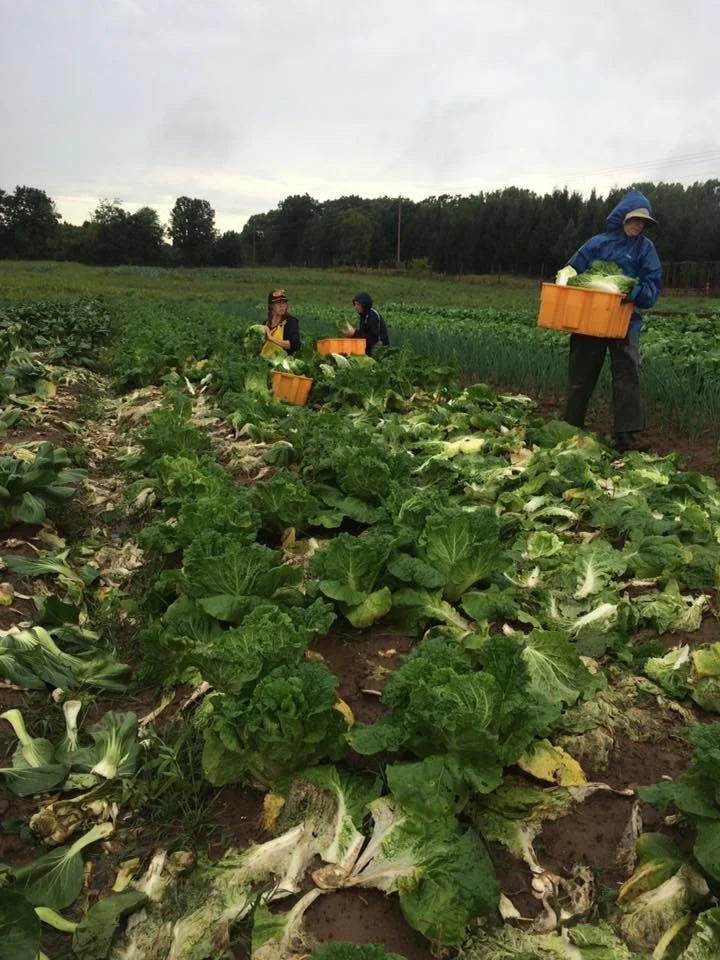Week 14; September 8, 2016
What's in the box?
Salad mix
butterhead lettuce
vitamin green
broccoli
carrots
bok choy
napa cabbage
cucumber
radishes
sweet red peppers
garlic
sweet onion
cilantro
heirloom tomato (large and medium)
Notes on the box.
Greens are back! It was a very rainy and muddy harvest, so be sure to give everything an extra rinse/ wash to get rid of any lingering dirt.
Cilantro was a little late to the party, so maybe if you still have some tomatoes you can add it to a salsa. If not, try the asian slaw recipe below or add to tacos or fajitas made with the lovely red peppers and onion.
Greens should all be stored in plastic bags in your fridge. Remove tops from radishes before storing.
Cosmic Wheel Creamery Cheese Share.
This week is plain quark and Antares, our cows milk manchego, aged 4 months. Made back in May when the grass was just really getting going! It's a good melter or good for snacking. I like the quark on a fancy little sandwich with cucumbers or radishes. It's also nice to mix in your favorite herbs and dollop onto salmon on scrambled eggs at the end of cooking.
Recipes.
Harissa Red Pepper Carrot Soup
Thai Quinoa Salad (you can substitute napa for red cabbage in this recipe)
Make room in the fridge by making this kimchi!
1 large Napa cabbage, cored and chopped into (roughly) 2 inch pieces
2-3 Tablespoons unrefined salt
some radishes, carrots, and turnips, thinly sliced
minced garlic (we like at least 2 cloves)
knob of ginger, peeled then minced or grated
1 teaspoon fish sauce (optional)
1 teaspoon crushed red chili pepper (optional or add more to taste)
Take a leaf off of the outside of the cabbage and set it aside. Place cabbage pieces in a large bowl, sprinkle salt on the leaves, then toss to distribute well. Allow to rest 30 minutes as the salt pulls moisture from the cabbage. Using clean hands or a wooden pounder, gently mash the cabbage leaves to further release juices. Add in the remaining ingredients and combine well. Transfer the kimchi mixture to a sterilized quart-sized wide-mouth jar, pressing down with a wooden pounder or your hand. Pack the jar so that more brine juices are released. Your goal is to fill the jar just up to 1-inch below the lip, allowing space for expansion. Cut or fold the reserved outer leaf to fit on top of the mixture and press it down so that the brine is above the leaf. If your cabbage did not exude very much moisture, you may need to add a little filtered water to the finished product so that the brine is above the kimchi ingredients.
Loosely cap the jar and place out of direct light in a dish to capture liquid that may bubble out of the jar as it ferments. Allow to ferment for 3 to 21 days (warmer temperatures make fermentation happen more quickly. The longer the kinchi ferments, the more pungent it will become). Add/remove brine if the level is not maintained at 1-inch below the lip of the jar. You should see occasional tiny bubbles rising along the inner sides of the jar as the veggies begin to ferment. After 3 to 21 days, move the kimchi to the fridge. Serve with beef, chicken, pork, eggs, as a condiment with rice.
The ideal household temperature for vegetable lacto-fermentation is 72 degrees. Fermenting may occur more slowly at cooler temperatures and more quickly at warmer temperatures
Enough salt in the ferment should keep mold from growing on your kimchi. Lacto-fermenting is considered to be a very safe technique for preserving foods but, when in doubt, throw it out.
On the Farm.
We didn't get greenbeans in the box this week. :( They hadn't *quite* sized up enough and we were a little short handed this week and the rainy muddy weather makes for a slowed harvest time overall. Next week is looking promising, though.
As mentioned in last weeks blog, the harvest party will be Sunday September 25th! Mark your calendar!





